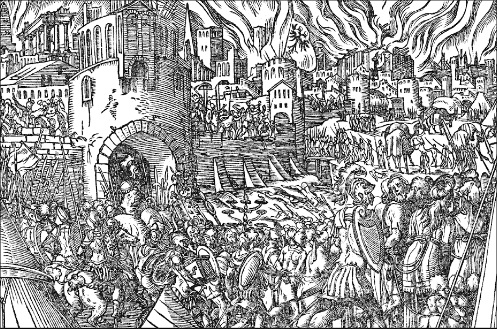
–>
October 26, 2022
Today in history witnessed one of the greatest defenses by a small Christian force against Islamic invaders, the relief of the siege of Croya (Krujë), Albania, in 1450.
‘); googletag.cmd.push(function () { googletag.display(‘div-gpt-ad-1609268089992-0’); }); }
Nearly four decades earlier, the leader of the Albanian forces, George Kastrioti — better known as Skanderbeg (“Lord Alexander”) — was taken captive as a child by the Ottoman Turks, and trained to be a janissary, a Christian slave turned Muslim soldier. Excelling at war, he quickly rose among the Ottoman ranks until he became a renowned general, with thousands of Turks under his command.
Despite all the honors showered on him, once the opportunity appeared, he showed where his true allegiance lay: he broke free of the Ottomans and fled to his native and continuously harried Albania. There, after openly reclaiming his Christian faith, he “abjured the prophet and the sultan, and proclaimed himself the avenger of his family and country,” to quote Edward Gibbon.
His “ingratitude” naturally provoked the Turks to no end and prompted wave after wave of jihadist invasions, each larger and crueler than its predecessor. Finally, in what was meant to be the campaign to end all campaigns, in the spring of 1450 Sultan Murad II himself led a gargantuan army of 160,000 men into Albania –straight for Skanderbeg’s stronghold, the White Castle.
‘); googletag.cmd.push(function () { googletag.display(‘div-gpt-ad-1609270365559-0’); }); }
Against this mammoth Muslim army, Skanderbeg could only raise some 18,000 Christian defenders. He evacuated all of the women and children from Croya, garrisoned it with 1,500 men, and took the rest into the nearby mountains, whence they would harass the besiegers and try to undermine their supply trains with guerilla tactics.
Meanwhile, all along their route to Croya, the Turks left a trail of devastation — countless Albanians were slaughtered or enslaved.
Murad finally arrived and put Croya to siege on May 14, 1450. Day after day, Ottoman cannons rocked the White Castle with projectiles weighing as much as four hundred pounds. As one contemporary wrote, the sultan “bombarded the walls with cannons and brought down a large section of them… But Skanderbeg lit fires from the mountain signaling to those in the city that when there was need, he would be there to assist them. He attacked some of the sultan’s men who went up the mountain and fought against them, performing remarkable deeds.”
Meanwhile, the janissaries terrorized and devastated the land of their former brother-in-arms, burning homes and grain fields.
Several Albanian nobles individually surrendered in the hopes of retaining their lands and titles; others actively welcomed the Turks in the hopes of breaking Skanderbeg’s influence. And Venice, once again, supplied the Islamic invader.
A Venetian report complained that “Skanderbeg is defending himself heroically” — so much so that, if not for Venetian provisions, the Turks “would have pulled up their tents” and retreated: “for this reason, it is feared that Skanderbeg, the moment he frees himself [of the Turks] will attack the lands of the Republic [of Venice in vengeance].”
‘); googletag.cmd.push(function () { googletag.display(‘div-gpt-ad-1609268078422-0’); }); } if (publir_show_ads) { document.write(“
 Similarly, after stating that Murad “attempts with all his might and vigorous battle to crush him [Skanderbeg],” a pessimistic letter offered a glimmer of hope: “the brave men inside are bound by honor to defend it to the death. Skanderbeg himself is not far from the Turkish tents and daily inflicts heavy losses on the enemy because he takes advantage of the nature of the country and the nearby mountains where he hides without being discovered.”
Similarly, after stating that Murad “attempts with all his might and vigorous battle to crush him [Skanderbeg],” a pessimistic letter offered a glimmer of hope: “the brave men inside are bound by honor to defend it to the death. Skanderbeg himself is not far from the Turkish tents and daily inflicts heavy losses on the enemy because he takes advantage of the nature of the country and the nearby mountains where he hides without being discovered.”
Skanderbeg and his men fought tooth and nail and managed to inflict heavy casualties on their much larger enemy. In the words of a nineteenth-century historian:
With matchless strategy he contrived to keep the myriads of his opponents from the walls… he swept unexpectedly, now here and now there, by night and by day, into the midst of the foe; every swordsman of his band hewed down scores, and his own blade flashed as the lightning and caused Moslem heads to fall like snowflakes where he passed. Thousands of the bravest warriors of Murad were thus swept away continuously. His hosts were diminishing to the point of danger to his very person.
At one point, Murad spotted Skanderbeg and his men on a reconnaissance mission on a mountain overlooking Croya. Shaking his head, the sultan was heard to mutter that perhaps “the best way was to let alone that furious and untamed lion” — to stop “feed[ing] that unhappy beast” with the blood of his men.
Murad persevered, however, as the breaching of Croya seemed imminent, the cannons having leveled so many of its ramparts. On an appointed day, after “the sultan had demolished a large part of the walls, he engaged his entire army in the battle.” The janissaries “attempted to seize the city at the place where the walls had collapsed to the ground. But they did not overcome those in the city, who were fighting beyond hope. He then decided to starve the city into surrender and made a second, most ferocious attack,” but that too failed.
Countless more Ottomans lay dead and dying. By now Murad was at his wit’s end: he “retired to his pavilion, overcome with grief and rage… tearing his hair and his beard, and pouring out blasphemous speeches against the majesty of heaven, seeming to call the Almighty in question for suffering his gray hairs and his former glory, and the Ottoman name, to be disgraced and humbled for the sake of a paltry castle in Albania.”
As might be expected, contemporary Ottoman chronicles are succinctly more sparing: Murad and his army “struck Croya with cannons and turned it into a graveyard. He hoped that they would surrender but they did not. Winter then arrived.”
And that was that: having marched one of the largest armies he had ever mustered, and having invested Croya for eight months, Murad resigned and lifted the siege on October 26, 1450. Some twenty thousand Turks had been killed for nothing.
Although Albania was devastated and plagued by starvation, “that Christmas was the happiest the people had enjoyed since” Skanderbeg had broken free of the Turks and returned to Albania.
Moreover, his epic defense against everything the sultan who had long terrorized southeastern Europe could hurl against him caused an explosion of euphoria throughout the West — not least as Murad had died soon thereafter, of shame, some said.
Pope Nicholas V hailed Skanderbeg a “Champion of Christendom,” and rightfully so. Had the Ottomans managed to transform Albania into a launching pad into Italy in 1450 instead of when they did, in 1480, Muhammad II, the Conqueror — modern-day Turkey’s hero — would have had thirty years, not just one, to pursue his long-cherished goal of conquering Rome and, from there, inundating Western Europe with his Eastern hordes.
That Skanderbeg was a quintessential Defender of the West was even acknowledged by the United States Congress, in a 2005 resolution titled, “Honoring the 600th anniversary of the birth of Gjergj Kastrioti (Scanderbeg), statesman, diplomat, and military genius, for his role in saving Western Europe from Ottoman occupation.”
For the full story of Skanderbeg — as well as several other Christian heroes who stood against Islamic jihad — see Ibrahim’s Defenders of the West, from which the above account was excerpted.
Image: Public Domain
<!– if(page_width_onload <= 479) { document.write("
“); googletag.cmd.push(function() { googletag.display(‘div-gpt-ad-1345489840937-4’); }); } –> If you experience technical problems, please write to [email protected]
FOLLOW US ON
<!–
–>
<!– _qoptions={ qacct:”p-9bKF-NgTuSFM6″ }; ![]() –> <!—-> <!– var addthis_share = { email_template: “new_template” } –>
–> <!—-> <!– var addthis_share = { email_template: “new_template” } –>





